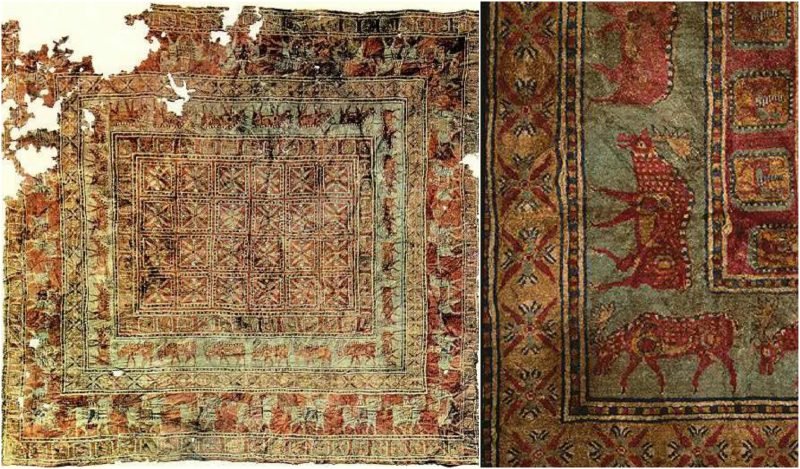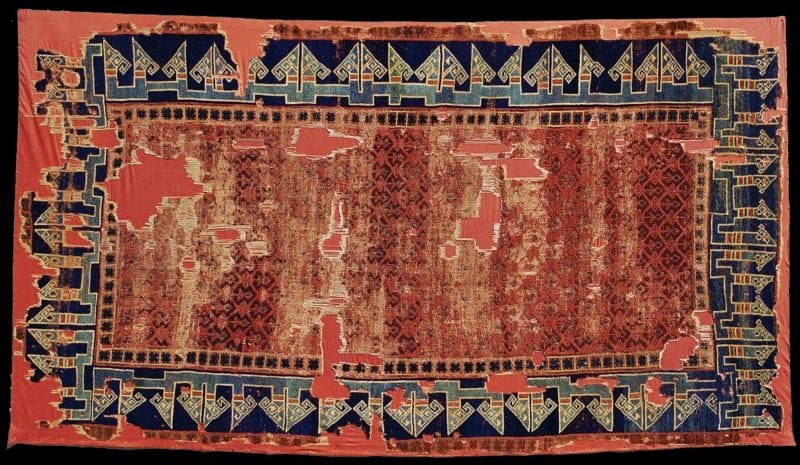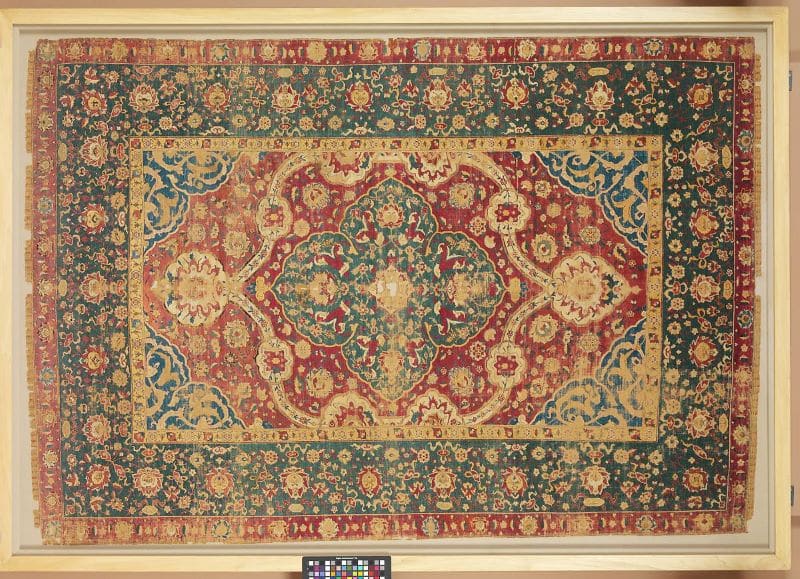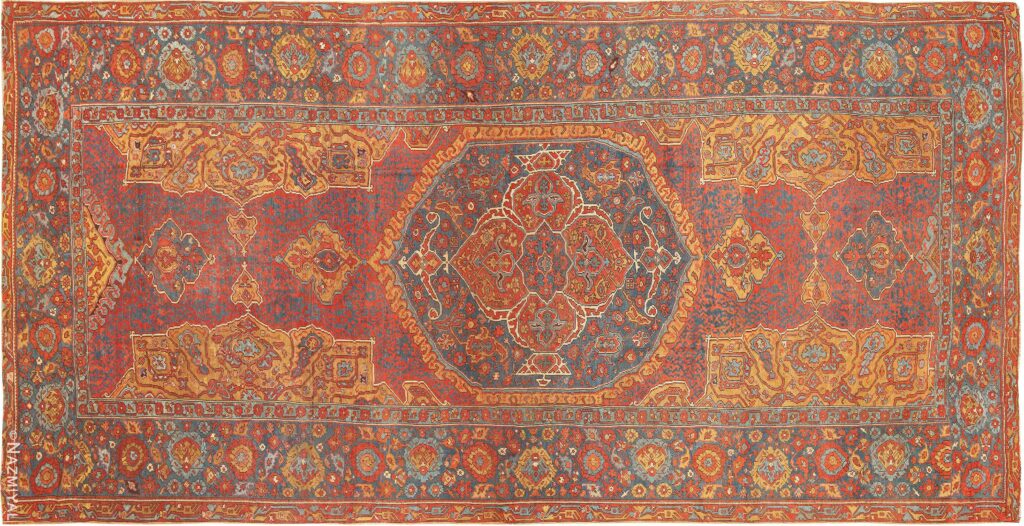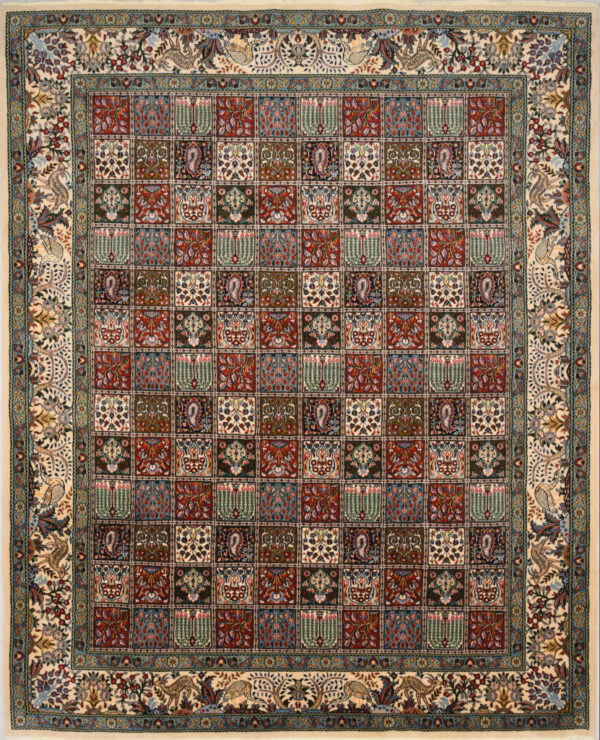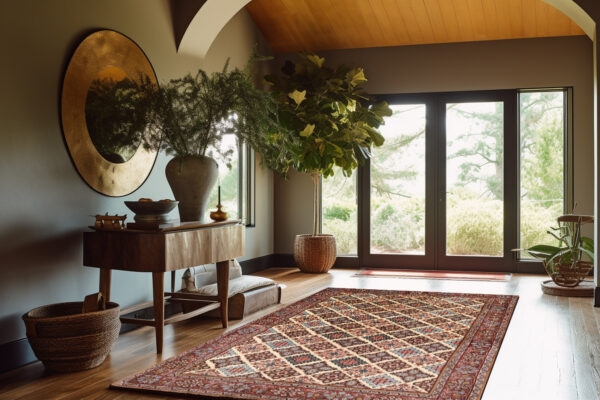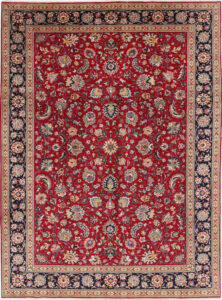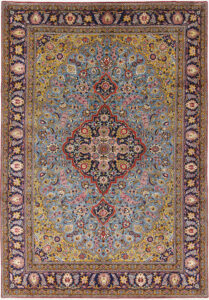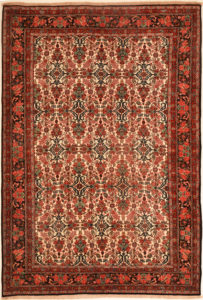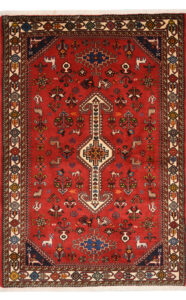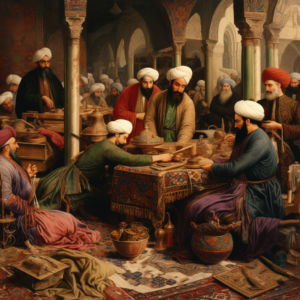Introduction
Brief Overview of the Rich History of Persian Rugs
The history of Persian rugs is a captivating journey that stretches back millennia.
These exquisite carpets are among the earliest ever created, tracing their origins to the Achaemenid Empire, which spanned Europe, Asia, and Africa from 550 B.C. to 350 B.C. The story begins with humble materials, as the first carpets were woven from bamboo and plant stalks harvested from the marshlands of lower Transoxania.
These early mats served their purpose but lacked the comfort and luxury of the Persian rugs we know today. In order to produce a more complete and better floor covering, men began to produce a kind of mat by intertwining the wools of animal.
Table of Contents
Cultural and Economic Significance of Persian Carpets
Throughout history, Persian rugs have held immense cultural and economic significance. Initially used as floor coverings in tents, they eventually became treasures fit for kings and palaces.
The Arch Palace of the Sassanid King Khosrow Parviz boasted a carpet of golden threads known as the “Four Seasons of Baharestan,” highlighting the luxury and prestige associated with these handcrafted masterpieces.
Evolution of Persian Rug Weaving from Ancient Techniques to Modern-Day Rug Weaving
A continuous refinement of techniques and designs has marked the evolution of Persian rug weaving. Initially, nomadic tribes in Central Asia used twisted wool fibers to create durable floor coverings that suited their practical needs.
With the advent of Islam in the 8th century, the Azerbaijan province became a global hub for Persian carpet and rough area rug production. Dye centers were established alongside weaving looms, fueling a thriving industry that persisted until the Mongol invasion of Persia.
Persian rug companies today owe their existence to these ancient artisans who laid the foundation for this art form years ago.
Origins and Ancient Techniques of Persian Rug Weaving
The Pazyryk Carpet: A Glimpse into the Past
The world’s oldest known pile-woven carpet, the Pazyryk carpet, was discovered in Siberia’s Pazyryk Valley within the tomb of a Scythian nobleman. Radiocarbon dating places its creation in the 5th century BC, making it a remarkable artifact from the past. This finely crafted carpet measures 183 by 200 centimeters (72 by 79 inches) and features an intricate design with 36 symmetrical knots per cm2 (232 per inch2).
The central field of the Pazyryk carpet showcases a deep red hue adorned with two animal frieze borders moving in opposite directions, accompanied by guard stripes. The inner main border features a procession of deer, while the outer border depicts men on horses and men leading horses, each with diverse saddlecloth designs. Within the inner field, rows of 4×6 identical square frames are set against a red background, each filled with matching star-shaped ornaments formed by overlapping x- and cross-shaped patterns.
Sergei Rudenko, the carpet’s discoverer, originally attributed it to the contemporaneous Achaemenids. However, debate continues regarding its place of production. Regardless of its origin, the Pazyryk carpet is a testament to the advanced state of carpet weaving during its era.
Ancient Weaving Techniques and Materials Used
The precise weaving techniques and materials used in the early Persian rugs remain somewhat of a mystery. Xenophon’s writings mention the opulence and diplomatic significance of Persian carpets, highlighting their value. However, whether these ancient rugs were pile-woven or crafted using alternative methods like flat-weaving or embroidery/textile remains unclear.
What we do know is that early Persian weavers were resourceful, utilizing materials such as bamboo, plant stalks, and wool fibers to create intricate patterns and designs.
Significance of Rugs in Ancient Persian Society and Culture
In ancient Persian society and culture, rugs played a significant role. Their use extended beyond mere floor coverings; they symbolized prestige, luxury, and diplomacy. Notably, Xenophon’s accounts emphasize Persian carpets’ worthiness as diplomatic gifts, underlining their opulent and prestigious nature.
As Persian society evolved, these rugs became more than utilitarian items; they became integral to the cultural and artistic identity of the region.
The Sasanian Era: A Reign of 400 Years (224–651)
The Sasanian Empire succeeded the Parthian Empire and thrived as one of the dominant powers for over 400 years. Geographically centered around the Achaemenid borders, with its capital in Ctesiphon, the Sasanian dynasty embraced Zoroastrianism as its state religion.
The exact origins of Persian pile carpet weaving during this era remain shrouded in mystery, but it’s clear that knowledge of carpet weaving and suitable floor covering designs was widespread throughout the region, including Byzantium, Anatolia, and Persia. This interconnection facilitated the exchange of artistic styles and decorative motifs.
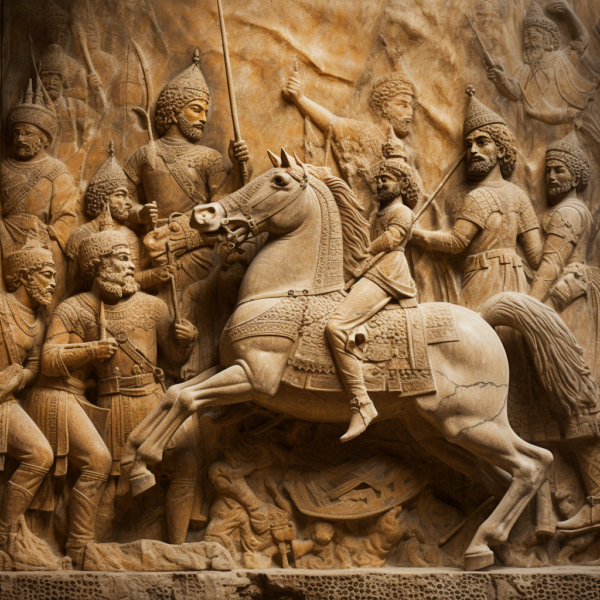
During the Sasanian period, flat weaving and embroidery were well-established crafts, as exemplified by exquisite Sasanian silk textiles found in various locations. However, the design and crafting techniques of the splendid court carpets described by Arab conquerors of the Spring of Khosrow carpet remain uncertain.
Fragments of pile rugs from northeastern Afghanistan, dating back to the early Sasanian period, provide insight into the region’s early carpet weaving. These rugs, featuring depictions of animals and utilizing wool for warp, weft, and pile, showcase the evolution of craftsmanship during this period.
The Rise of Islam and the Era of the Caliphates: 651–1258
The Muslim conquest of Persia marked the end of the Sasanian Empire and the gradual integration of Persian culture into the Islamic world under Muslim Caliphates. It was during this time that Arabian geographers and historians began to provide the first references to the use of carpets as floor coverings in Persia. These references highlight that the carpet making and weaving in Persia during the Caliphate era was primarily a rural or tribal industry.
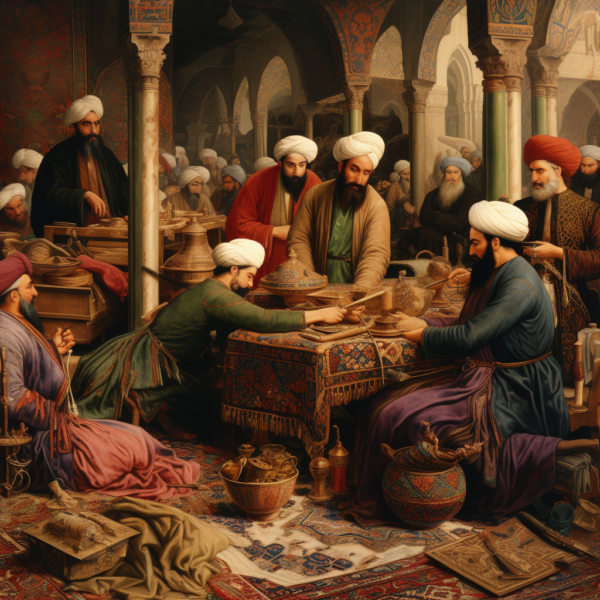
The Seljuk Impact and the Birth of the Turko-Persian Tradition (1040–1118)
The Seljuk invasions into Anatolia and northwestern Persia led to the emergence of a unique Turko-Persian tradition. Fragments of woven carpets from this era offer insights into the appearance of Seljuk Turk carpets, although their influence on Persian carpet weaving remains uncertain.
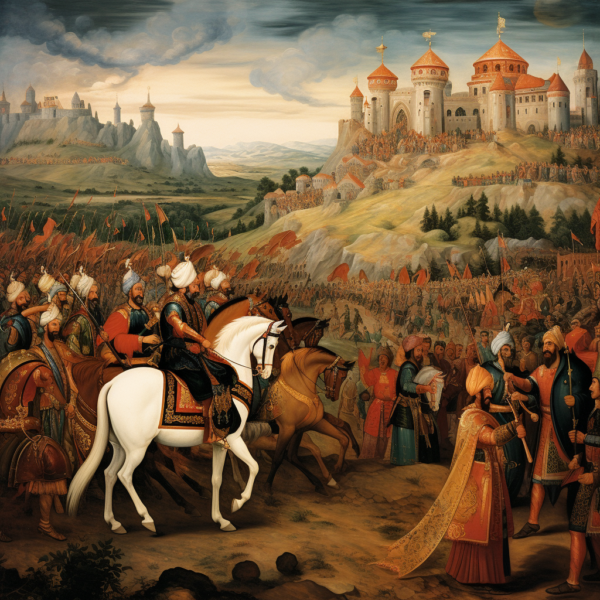
Mongol Influence in the Ilkhanate and the Flourishing Timurid Era (1256–1335, 1370–1507)
The Mongol invasions brought turmoil to Persia, and the subsequent establishment of the Ilkhanate saw the use of Persian carpets in notable residences. The Timurid Empire and its influence on Persian carpet weaving are exemplified by historical accounts and artistic depictions of carpets featuring geometrical designs, knot patterns, and script-inspired rug borders.
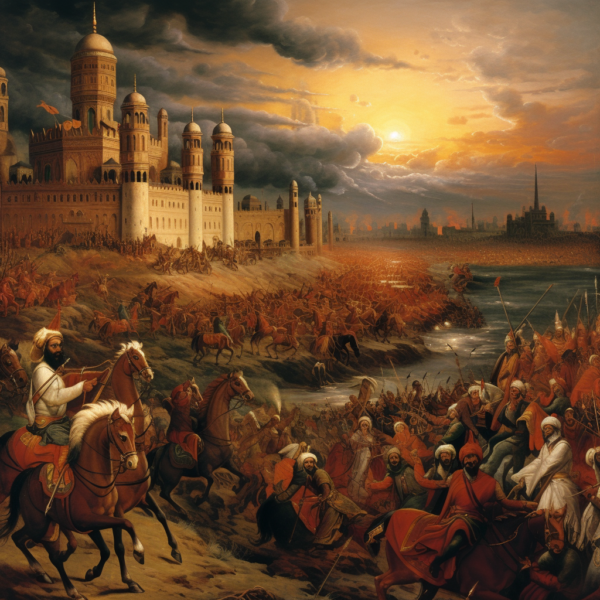
While many early Persian carpets have not survived to the present day, the evolution of weaving techniques and artistic influences during this period laid the foundation for the rich tradition of Persian rug craftsmanship that we admire today.
The Flourishing of Art under the Safavid Dynasty
The Safavid Period (1501–1732) marked a significant chapter in Persian history, often referred to as Iran’s “Golden Age.” During this era, Persian art, poetry, and culture flourished, giving rise to an artistic renaissance. Renowned poets like Hafez and Saadi, along with artists like Reza Abbasi, played pivotal roles in this cultural revival.
Introduction to the Safavid Dynasty and Its Impact on Arts and Culture
In 1499, the Safavid Dynasty emerged with Shah Ismail I as its founder. Shah Ismail I is celebrated for his role in establishing Shi’a Islam as Persia’s state religion, making him the first national sovereign of Persia following the Arab conquest. Subsequent rulers like Tahmasp I and Shah Abbas I further championed the cause of Persian Safavid art.
During this period, the Safavid Dynasty nurtured an environment of artistic and cultural growth. It was a time when exquisite Persian carpets were made and various other art forms reached new heights of sophistication and complexity.
Exploration of Design Evolution, Materials, and Weaving Techniques During This Period
The Safavid era witnessed significant advancements in carpet weaving, a highly regarded art form. While no early Safavid carpets have survived, researchers have turned to Timurid period book illuminations and miniature paintings for insights into the era’s carpet designs. These artworks depict vibrant, intricate carpets featuring repeating geometric patterns, often arranged in checkerboard-like designs, complemented by border ornaments inspired by Islamic calligraphy.
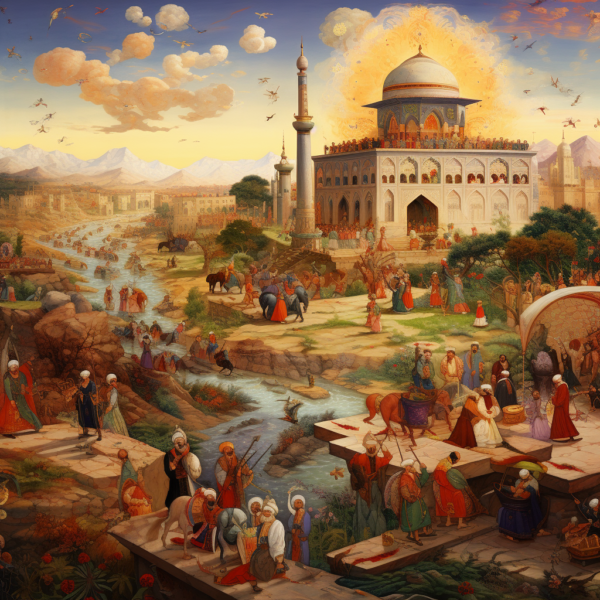
Notably, these designs shared striking similarities with Anatolian carpets of the same era, suggesting a cross-pollination of design influences. Safavid rugs were renowned for their sinuous patterns and arabesques, developed initially in manuscript illumination and architectural decor, giving rise to a unique antique rug style. The Safavids also played a pivotal role in refining weaving techniques, enabling the creation of intricate curvilinear details.
The Role of Rugs in Safavid Society, Politics, and International Relations
Carpet weaving during the Safavid era was not just a craft; it held profound significance in society, politics, and international relations. Shah Abbas the Great (1587-1629) was a prominent patron of the arts, contributing to the evolution of decorative arts during this period. He was not only a ruler but also a painter and carpet designer.
Safavid design transitioned from curvilinear to rectilinear during this era, leading to the emergence of new and intricate patterns. These patterns were meticulously drawn on cartoons, serving as a guide for the artists who brought them to life through weaving. While only a limited number of Safavid carpets have survived to the present day, each of them stands as a testament to the artistic excellence of the period.
Safavid Dynasty established four major rug weaving centers in central Persia, Tabriz, Kerman, and eastern Persia. Tabriz, which initially served as the Safavid capital, was known for its significant weaving industry. Central Persia, particularly Kashan and Isfahan, was renowned for silk pile rugs. Shah Abbas, during his reign, set up a factory in Isfahan to produce silk and metal brocaded carpets, marking a significant transformation in carpet weaving.
These precious carpets, with their intricate designs, are not only a reflection of Safavid artistry but also an embodiment of the period’s cultural, artistic, and political significance. One of the most celebrated Safavid carpets, the Ardabil Mosque carpet dated 1539, now graces the Victoria and Albert Museum in London, a masterpiece that exemplifies the opulence and artistry of the Safavid era.
Revival and Modernization during the Qajar Dynasty
The Socio-Political Context of the Qajar Dynasty and Its Impact on the Arts
The Qajar Dynasty, which spanned from 1789 to 1925, marked a pivotal period in Persian history. Mohammad Khan Qajar’s ascent to the throne in 1789 brought relative stability and peace to Persia. This era provided a conducive environment for the resurgence of the Persian carpet industry and a broader revival of traditional arts.
During the Qajar Dynasty, three influential monarchs—Fath-Ali Shah Qajar, Naser al-Din Shah Qajar, and Mozaffar ad-Din Shah Qajar—played significant roles in preserving and promoting Persian cultural traditions. Their reigns witnessed a reinvigoration of Persian arts, including carpet weaving, as they sought to reaffirm the rich cultural heritage of Persia.
Efforts to Revive and Preserve Traditional Rug Weaving Techniques
Around 1885, weavers in Tabriz, a city in northwestern Persia, emerged as pioneers in the modernization of the carpet weaving industry. They embarked on a mission to preserve and revitalize traditional techniques of weaving carpets that had been passed down through generations. This revival of age-old methods not only honored the craftsmanship of Persian carpet weavers but also aimed to maintain the cultural identity that these rugs represented.
Under the patronage of the Qajar rulers, master weavers and artisans took great care in preserving the authentic techniques and intricate craftsmanship that had defined Persian rugs for centuries. This dedication to tradition served as a powerful bridge connecting the past to the present.
Introduction of New Designs, Materials, or Techniques During This Period
While the Qajar Dynasty placed a strong emphasis on upholding traditional weaving techniques, it also embraced innovation in the world of Persian rugs. Weavers and artisans explored new designs, materials, and techniques to breathe fresh life into this ancient art form.
The Qajar era witnessed a harmonious blend of tradition and modernity in rug weaving. Weavers introduced subtle variations and creative designs that retained the essence of Persian culture while adapting to the changing times. This fusion of tradition and innovation ensured that Persian rugs remained not only an integral part of Persian heritage but also a reflection of the evolving artistic sensibilities of the period.
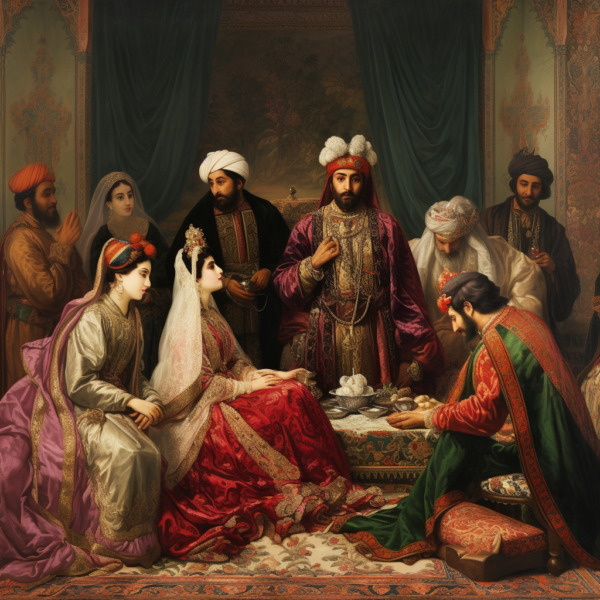
he Qajar Dynasty’s commitment to preserving and modernizing the art of rug weaving underscored the enduring importance of Persian carpets in the nation’s cultural identity. It was a period that celebrated both the timeless traditions of the past and the dynamic spirit of progress, ensuring that Persian rugs continued to captivate the world with their beauty and significance.
Persian Rugs in the Modern Era: 19th Century
Challenges Faced by the Persian Rug Industry in Contemporary Times
The Persian rug industry, which has thrived for centuries, confronts various challenges in the modern era. One of the most significant challenges is the competition posed by machine-made rugs. The advent of modern manufacturing techniques and the ability to produce rugs quickly and cost-effectively has led to an influx of machine-made imitations of traditional Persian designs. These machine-made rugs often lack the artistry and cultural significance that characterize authentic handmade Persian rugs.
Additionally, political and economic challenges have impacted the Persian rug trade. Sanctions and embargoes imposed on Iran have limited its ability to export these exquisite creations. This has resulted in a shift in the global market, with competition emerging from other rug-making regions and countries that benefit from lower labor costs and more cost-effective production methods.
Modern Innovations in Design, Materials, and Marketing
Despite these challenges, the Persian rug industry has demonstrated resilience and adaptability. In the 1970s and 1980s, a newfound interest in Persian Gabbeh rugs emerged in Europe. These handmade rugs that, originally woven by nomadic tribes for personal use, captivated Western consumers with their rustic weaving techniques and simple, abstract designs. This interest fueled the industry’s ability to adapt to evolving market demands.
In 1992, the Grand Persian Conference and Exhibition in Tehran marked a significant turning point. Renowned Persian master rug weavers began showcasing modern Persian carpet designs that combined traditional techniques with contemporary designs. This innovation breathed fresh life into the industry, ensuring that Persian rugs remained relevant in the modern era.
Another modern innovation lies in the revival of natural dyes, particularly among commercial enterprises that commission tribal design rugs and carpets from village weavers. This practice ensures a consistent source of income for these weavers. While companies may provide materials and specify designs, they also allow weavers a degree of creative freedom, preserving the artistic spirit of Persian rug-making.
The Current Global Status and Perception of Persian Rugs
Despite the challenges and changing market dynamics, Persian rugs maintain their esteemed status in the modern era. These handcrafted works of art, often made from sheep wool dyed with natural colors, continue to be sought after. Their extensive manual labor and artistic designs contribute to their enduring value and prestige.
Persian rugs are not merely floor coverings; they are symbols of luxury, beauty, and art. They evoke a sense of tradition, history, and culture that resonates with collectors, enthusiasts, and interior designers around the world. While the global market may have evolved, the enduring appeal of Persian rugs persists, solidifying their position as timeless treasures that transcend time and trends.
The Craftsmanship Behind Persian Rugs
A Detailed Look into the Process of Making a Persian Rug
The creation of a Persian rug is a meticulous and time-honored process that involves several steps, from the shearing of wool to the final product. This craftsmanship has been passed down through generations, and each step plays a crucial role in the rug’s ultimate quality and beauty.
Wool Shearing: It all begins with the careful shearing of sheep. The wool is collected and sorted to ensure it meets the required quality standards. The finest wool is selected for rug-making.
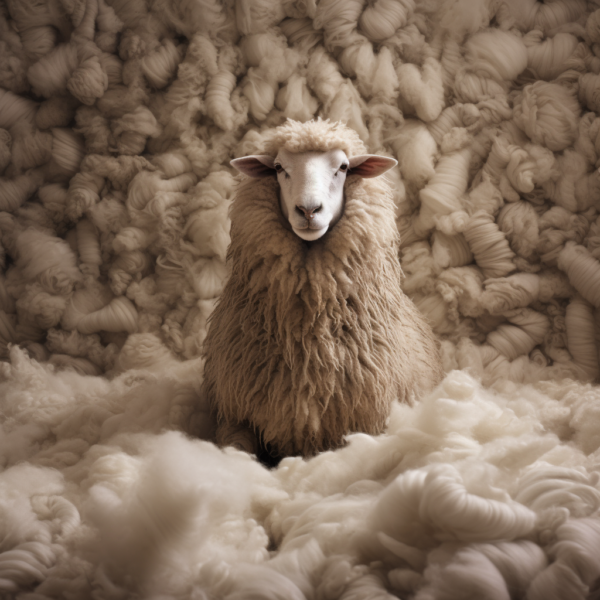
Wool Washing: The collected wool is washed to remove any impurities, dirt, and natural oils. This step ensures a clean and ready-to-dye material.
Dyeing: Natural or synthetic dyes are used to achieve the desired colors. Some weavers adhere to traditional methods, using natural ingredients like plants and insects to create an array of hues. The choice of dye and its preparation contribute to the rug’s unique character.
Design and Pattern Creation: The design and pattern are drawn on a paper or cardboard template. Master weavers may create these intricate patterns from memory, while newer designs often follow templates.
Setting Up the Loom: The loom is set up with warp threads that run vertically. These threads are stretched tightly to create the foundation for the rug.
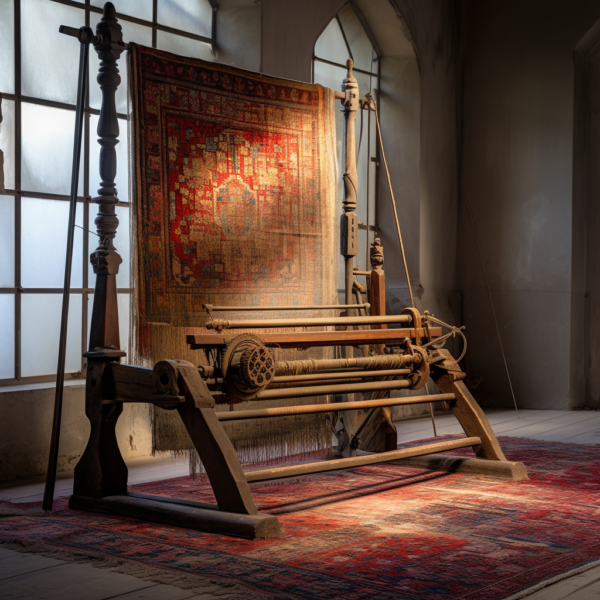
Knotting: Weavers use either the symmetrical (Turkish) or asymmetrical (Persian) knotting techniques to create the pile. Each knot is tied around two adjacent warp threads, with the weaver’s fingers and a comb ensuring precision.
Shearing and Trimming: After weaving, the rug’s pile is sheared to an even length. This reveals the intricate patterns and allows for a smoother, more luxurious surface.
Washing and Finishing: The rug undergoes a thorough washing to remove any remaining dye or impurities. It is then laid out in the sun to dry. The final touches, like fringing and binding, are added to complete the rug.
Designs, Patterns, and Symbols
Persian rugs are celebrated for their diverse designs, patterns, and symbols, each of which carries its own significance. Common motifs found in Persian rugs include:
Floral Patterns: Persian rugs often feature intricate floral designs, with each flower symbolizing different aspects of life. Roses represent love and beauty, while tulips signify growth and rebirth.
Geometric Patterns: Geometric patterns are also prevalent, often inspired by Islamic art and architecture. These designs can range from simple shapes to complex, interconnected motifs.
Medallions: Many Persian rugs have a central medallion, which represents the heart or soul of the design. The medallion is surrounded by a field filled with complementary patterns.
Animal and Bird Motifs: Animals and birds are woven into the rug’s patterns, often symbolizing strength, protection, or elements of nature.
Garden and Paradise Imagery: Persian rugs frequently depict idyllic gardens or paradises, reflecting the Persian love for nature and the aspiration for an ideal world.
The Significance of Colors and Dyes
Colors and dyes play a pivotal role in Persian rug-making, reflecting the culture, history, and artistic traditions of the region. Natural dyes, derived from plants, insects, and minerals, have been used for centuries. The significance of colors in Persian rugs is profound:
Red: Symbolizes love, passion, and wealth. It is one of the most common colors in Persian rugs.
Blue: Represents the heavens, spirituality, and wisdom. Deep blues are often seen in Persian rugs.
Green: Signifies nature, growth, and fertility. Green is associated with the lush landscapes of Persia.
Yellow: Symbolizes the sun and happiness. It brings warmth and brightness to rug designs.
Black: Represents power, mystery, and protection. It is used to create bold outlines and frames in many rugs.
White: Symbolizes purity and spirituality. It is often used in contrast with other colors to create balance.
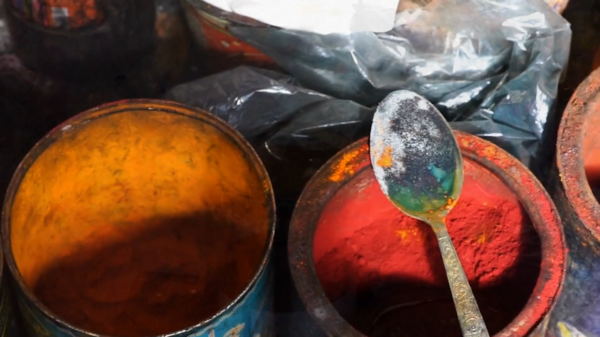
The selection and combination of these colors in Persian rugs are deliberate and are often tied to cultural or regional influences. The artistry lies in the weaver’s ability to harmonize colors, patterns, and symbols, creating a masterpiece that tells a story and evokes emotions.
The Global Impact and Future of Persian Rugs
Persian Rugs in International Markets and Global Perception
Persian rugs have long held a revered place in the international market, captivating the world with their exquisite craftsmanship, intricate designs, and rich history. They have been sought after for centuries, not only for their practical use but also as collectible works of art. Persian rugs continue to make a significant impact in global markets, and their perception remains one of prestige and timeless beauty.
Luxury and Elegance: Persian rugs are synonymous with luxury and elegance. Their handcrafted nature, along with the use of high-quality materials and traditional dyeing techniques, contributes to their premium status in the global market. They are often considered investments, passed down through generations.
Artistic Significance: Persian rugs are not mere floor coverings; they are woven pieces of art. The intricate designs, patterns, and symbolism tell stories of Persian culture and history. They find their place not only in homes but also in galleries and exhibitions worldwide.
International Collectors: Persian rugs have attracted a dedicated community of international collectors. These collectors appreciate the historical and artistic value of these rugs, often seeking rare and antique pieces. Persian rugs auctions and sales at prestigious auction houses draw global attention.
Interior Design and Decor: Persian rugs play a vital role in interior design and decor worldwide. They are used to add warmth, color, and a touch of culture to homes and commercial spaces. Interior designers often incorporate Persian rugs to create unique and inviting environments.
Preservation of Tradition: The global demand for Persian rugs has contributed to the preservation of traditional rug-making techniques. This demand sustains the livelihoods of skilled weavers and artisans in Iran and neighboring regions, ensuring the continuity of a centuries-old craft.
The Role of Persian Rugs in Global Culture, Art, and Design
Persian rugs have transcended their utilitarian origins and become cultural ambassadors, representing the artistry and heritage of Persia to the world. Their impact extends beyond floor coverings:
Cultural Exchange: Persian rugs serve as cultural bridges, fostering connections between East and West. They carry the essence of Persian culture to homes and institutions around the globe, sparking interest in the traditions, stories, and history of Iran.
Art Galleries and Museums: Persian rugs are featured in art galleries and museums worldwide, underlining their status as valuable works of art. They are displayed alongside other art forms, demonstrating their significance in the broader artistic context.
Influence on Global Design: The designs and patterns found in Persian rugs have influenced global design trends. Elements such as intricate motifs, color combinations, and geometric patterns have made their way into contemporary interior design, textiles, and fashion.
Rug Revivals: The love for Persian rugs has inspired rug revivals in other regions, where weavers and skilled designers seek to replicate the beauty and craftsmanship of Persian rugs. This influence can be seen in the rugs produced in places like Turkey, India, and Afghanistan.
Future Prospects, Challenges, and Opportunities for the Persian Rug Industry
While Persian rugs continue to thrive globally, the industry faces several challenges and opportunities for the future:
Global Competition: The Persian rug industry faces competition from machine-made rugs and rugs produced in countries with lower labor costs. Maintaining the authenticity and quality of handmade Persian rugs is crucial.
Economic and Political Challenges: Economic sanctions and political instability in Iran have presented challenges for the industry. However, there is potential for change and improved trade relations in the future.
Innovation: Embracing modern technologies and innovative designs while preserving traditional craftsmanship can open new avenues for the Persian rug industry. Combining tradition with contemporary appeal can attract a broader audience.
Sustainability: Sustainable and ethical practices, including the use of natural dyes and support for weaver communities, can enhance the industry’s reputation and marketability.
Cultural Preservation: Efforts to document and preserve traditional rug-making techniques, patterns, and designs are essential for the industry’s future. Training the next generation of weavers and artisans is vital.
Conclusion
The rich tapestry of Persian rugs intertwines history, craftsmanship, and culture. From their modest beginnings in the Achaemenid Empire to their grandeur during the Safavid Dynasty, Persian rugs have symbolized more than just floor coverings; they represent the cultural identity of a nation. The Qajar Dynasty’s efforts in preserving tradition while introducing innovation created a bridge from the past to the present, ensuring the rugs’ continued significance.
Looking ahead, the Persian rug industry faces challenges from machine-made imitations and economic sanctions. Yet, it has embraced modernity, innovation, and ethical practices, keeping its artistry alive. Persian rugs persist as symbols of luxury, culture, and artistry, transcending time and reflecting both a nation’s heritage and a shared global cultural tapestry. These intricate patterns and vibrant colors will continue to inspire and captivate, preserving the timeless beauty of Persian culture for generations to come.
